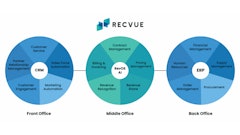
Global trade networks are cracking under the pressure of recent changes and events. Meeting heightened consumer expectations driven through omnichannel demand while dealing with the complexities of both national and global trade networks requires the application of new and emerging technologies to optimize business processes and operations. Product variety, configuration options and more frequent new product introductions have led to an explosion of SKUs. Think about your network trading infrastructure. If your network includes a few thousand retail outlets being supplied by a few thousand suppliers each providing just a few items, this calculates into item level stocking locations approaching 100 million. In this age of Industry 4.0 where companies want to get as close as possible to lot size 1 consumption by the end consumer, the industry is faced with a complex problem in providing 100% customer service levels at the lowest possible cost.
Working both closely and collaboratively with the multi-tier network partners that provide products and the related transportation, distribution, product safety, warehousing, inventory management, manufacturing and co-manufacturing is a necessity, but continues to be a major challenge.
For example, partner onboarding onto your supply chain network. For most companies, the process is painful, slow and when achieved, fails to deliver the expected results. Today’s process of connecting partner systems goes beyond the initial integration of traditional hub and spoke enterprise resource planning (ERP) systems.
For these hubs to be successful, suppliers and carriers who onboard into a network must consider themselves full trading partners, so that the ecosystem of the network can flex as demand and supply shifts from what was forecast. This can occur slowly or rapidly to meet unexpected events similar to how supply is being managed with the Coronavirus disease (COVID-19). Data still sits in silos, and when moved, becomes stale. This “paving of a new road” for each partner has frequently been slow, resource intensive and incredibly rigid, robbing organizations of the ability to quickly adapt to changes in the industry and the market.
Failure to solve partner onboarding is also costly. Poor data sharing within the company and between partners means it is difficult to both secure consumer product safety as well as exploit new market opportunities while optimizing the supply chain across partners. Many issues in the supply chain are preventable, if caught in time. Yet, stale data and poor data sharing means these issues go undetected and unaddressed and develop into major problems such as stockouts, waste and production stalls. Opportunities to optimize the supply chain through aggregating orders and shipments and optimizing logistics are also lost.
On the strategic level, poor data and communication between partners can lead to subpar decision-making over the longer term, which can negatively affect competitiveness and profitability.
Why artificial intelligence alone won’t fix your supply chain
Vendors continue to evolve their fundamentally flawed systems that were built primarily for a single enterprise with bolt-on fixes for integration and collaboration. This builds ever-increasing complexity into their systems to make them work in an increasingly connected and collaborative economy. However, the underlying architecture is ill-suited and makes it virtually impossible to have a real-time, single version of the truth for all members of the ecosystem. The bottom line is that decision-making is over-simplified, aggregate and gross average, which results in poor performance. Increased inventory, capacity, transportation and logistics costs are necessary to buffer for all variances. And, despite these costly measures, the result is still poor order fill rates and associated customer service levels.
Some companies bet their futures on digitization and think artificial intelligence (AI) or cloud apps will fix it. But, without a true multi-party network architecture in place to support all constituents and systems on the network, and to enable seamless data-sharing, any algorithms running are going to be constrained by partial and stale data, providing recommended actions which generate suboptimal or even poor results.
A new approach to the business operating system
A business operating system (BOS) has traditionally been viewed as an enterprise-wide set of business processes and related decision-making capabilities. Usually, the BOS extends across the enterprise structure, principles and the practices necessary to drive the organization to success both strategically and tactically.
And, while traditional hub-and-spoke system architecture has been serviceable in providing a somewhat self-centered trading capability, new network business operating systems are toppling long-established incumbents across many industries. Retail is reeling, and of course hotels and taxis have been hit too, but the ripple is widening to disrupt other industries, such as restaurants, automotive and manufacturing. No industry will be left untouched.
Network business operating systems are on the rise because of their distinct advantages over the traditional, enterprise-centric model, including:
· Networked. This means it prioritizes not just the enterprise, but also the optimal functioning of the ecosystem with real-time connectivity and a single version of the truth. This connectivity is virtual rather than hardwired, so connections between companies can be enabled and disabled almost instantly. This extreme agility and flexibility allow companies to make and modify partnerships quickly, so if a supplier is on the network, you can connect and transact with them. Likewise, for customers and carriers.
· Single version of the truth. The importance of a multi-party network with a single version of the truth can hardly be overstated. It simplifies data models, processes and workflows. For instance, on a network, there is a single representation for the purchase order and the sales order, as they are the same transaction. The result is there’s no need to reconcile purchase order with invoice and receipt.
· Dual platform. Most companies are running multiple legacy and ERP systems. There’s no need to shed these if they provide value. The network platform provides a new business process environment across all lines of business and can federate the financials across multiple ERP installations. This also means that where it makes sense, your trading partner’s systems and data can be leveraged across the network. An advanced network BOS is capable of delegating and orchestrating workflows across multiple systems of record and multiple parties to create an end-to-end, multi-enterprise workflow spanning network services and legacy systems.
· Master data management (MDM). For true digitization of the ecosystem and to enable a network BOS, companies need a robust multi-enterprise MDM capability that runs through the network. This provides a common language for communication across the network community and is essential for the new organizational ecosystem. For example, MDM enables companies to communicate incremental engineering and formulation changes, with details about bill-of-material updates and effective dates, between engineering and supply chain departments. This can happen internally and across every tier of contract manufacturers and suppliers. MDM on a network BOS provides a complete representation of the value chain, from inbound supply to outbound fulfillment, so companies can operate digitally, across their multiple ERP instances and other systems. The business network and its MDM system become the primary operational system of record for the supply chain.
· Intelligent. Due to the volume of data across your network that needs to be addressed, AI is necessary to help manage the supply chain across a network BOS. It’s impossible for planners and managers to monitor and intervene whenever there is an issue to keep a complex global supply chain running efficiently and smoothly. Within the network, one can apply two levels of AI capability. The first being RPA and the second is types of quantitative algorithms used in decision-making. This includes rule-based engines like what’s used to make decisions around alternate sourcing or substitute parts; heuristics like what’s used for supply/demand netting; algorithms like what’s used for optimizing to objectives (such as to revenue, cost or profit); machine learning like what’s uses when extending the data model to include new variables such as weather and traffic patterns; and finally deep learning for true pattern recognition. AI running on a network BOS empowers decision-making capability ten-fold, both to resolve issues before they happen and to address issues once they happen.
Gain traction
Companies who adopt this new model of a network BOS are realizing quick and substantial gains. Recent case studies show some companies achieving forecast accuracy in the 95% range, driving order fill rates/on-time, in-full to 99% and reducing inventories by 50%. Companies have also reduced supplier expediting costs by 60%, premium transportation by 50% and reduced cost of goods sold by 3%. The manual effort involved in planning and execution also decreases dramatically, sometimes by as much as 40% or more.
















![Pros To Know 2026 [color]](https://img.sdcexec.com/mindful/acbm/workspaces/default/uploads/2025/08/prostoknow-2026-color.mduFvhpgMk.png?ar=16%3A9&auto=format%2Ccompress&bg=fff&fill-color=fff&fit=fill&h=135&q=70&w=240)




